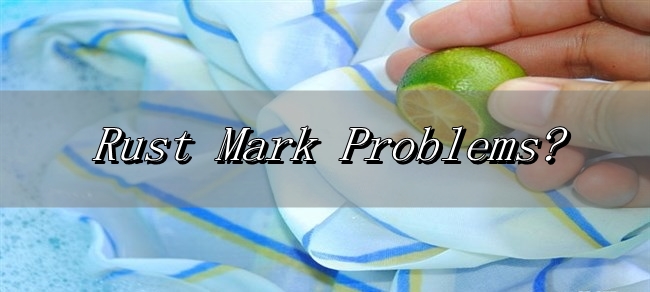How To Deal With Rust Marks? Rust “iron mold” may seem like a difficult mark to remove, but in fact, it does not require any drastic treatment.
Lemon juice is useful as a gentle treatment for rust stains. If you do not have any fresh lemons on hand, lemon juice from a bottle works just as well.
Hold a white, absorbent pad under the rust stain, and apply lemon juice from the cut half of a lemon. Cover the lemon juice with salt, and let dry for an hour (if possible, in the sun). Rinse off, then launder.
Other Surfaces
• On carpets Remove rust marks with a commercial rust remover, following the instructions carefully.
• On nonwashable fabrics Use a commercial rust remover, then wipe with a damp cloth. A little lemon juice may help (be careful not to overwet the area).
Soot Marks
These are a common problem in homes that have open fires.
Soot marks should wash out of clothes easily – but use a spray stain remover on any persistent stains.
Light Marks
Dusting off soot:Keep soot marks at bay by cleaning your fireplace surround regularly, either with a vacuum- cleaner attachment or a brush.
On Carpets
Basic treatment Vacuum well, or shake the carpet or rug. Do not brush the area because this will spread the mark. If this is not effective, apply unscented talcum powder, then vacuum. Have any large stains on carpets professionally dry cleaned.
Soot Stains
Scrubbing marks: If soot marks cannot be brushed or vacuumed away, scrub them vigorously with clean water, using a stiff scrub brush.
On Stonework
Stubborn marks: Use a weak solution of dishwashing liquid on stubborn soot marks on stonework, then scrub the whole area with clear water. Treat heavy soot marking with a concentrated solution of household bleach, then rinse the area thoroughly.
Persistent Stains
Using acidic cleaners… Apply white vinegar on a sponge or brush to tough stains. Rinse well. If marks persist, treat with some spirit of salts.
WARNING!
Spirit of salts is a solution of hydrochloric acid in water and is poisonous and highly corrosive. Wear rubber gloves and protective goggles when handling this substance.
Other Stains
Most stains can be removed using the methods described previously. If you are faced with a mysterious stain, follow the treatment for the most similar substance, testing carefully first.
Stain Treatment Stain Treatment
Baby Formula: Do not allow the stain to set.
Hair Oil: On wooden headboards, rub with turpentine.
Carbon Paper: Dab stain with denatured alcohol. Heat Marks
Coal: Brush off marks. Launder clothes in warm water.
Newsprint: Apply denatured alcohol on a cloth, then rinse well.
Shellac: Act quickly. Dab with denatured alcohol.
Copier Toner Powder: Brush off deposit, then wash the item in warm water.
Duplicating Ink: Dab marks with undiluted dishwashing liquid.
Embroidery Transfer: Dab with denatured alcohol, then launder.
Stains on Difficult Surfaces
On Wood
• Unvarnished wood: Stains on unvarnished wood -are almost impossible to remove. Bleach what you can, then wash the area with some detergent solution. Seal the surface with varnish to prevent future marks.
On Skin and Hair
• Paint stains: Use turpentine to remove oil-based paint from skin and hair or try vegetable oil on the skin. Protect your hair with a cap when painting.
• Ink stains: Scrub ink marks on the skin with a nail brush dipped in vinegar and salt.
• Other stains: Use pure lemon juice to remove dye stains and adhesive marks on the skin.
On Other Surfaces
• Paper: Remove grease spots by laying a piece of blotting paper over the mark and ironing with a warm iron.
• Glass: Use white vinegar to remove grease marks on the glass.






